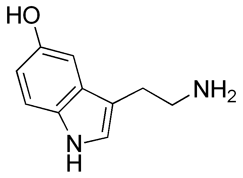Serotonin
| Serotonin | |
|---|---|
| Chemical name | 5-Hydroxy-tryptamine or 3-(2-aminoethyl)-1H-indol-5-ol |
| Chemical formula | C10H12N2O |
| Molecular mass | 176.22 g/mol |
| CAS number | 50-67-9 |
| SMILES | NCCC1=CNC2=C1C=C(O)C=C2 |
 3D structure of serotonin | |
Serotonin (5-hydroxytryptamine, or 5-HT) is a monoamine neurotransmitter synthesised in serotonergic neurons in the central nervous system and enterochromaffin cells in the gastrointestinal tract.
Serotonin is believed to play an important part of the biochemistry of depression, migraine, bipolar disorder and anxiety. It is also believed to be influential on sexuality and appetite.
The name "serotonin" is something of a misnomer and reflects the circumstances of the compound's discovery. It was initially identified as a vasoconstrictor substance in blood serum - hence "serotonin", a serum agent affecting vascular tone. This agent was later chemically identified as 5-hydroxytryptamine (5-HT) and as the broad range of physiological roles were elucidated, 5-HT became the preferred name in the pharmacological field.
Biochemistry
Serotonin is found extensively in the human gastrointestinal tract, or gut, as well as in the blood stream.
In our body, serotonin is synthesized from the amino acid tryptophan by various enzymes as shown in the reaction below.
Serotonin taken orally does not pass into the serotonergic pathways of the central nervous system (CNS). This is due to the blood-brain barrier preventing serotonin in the blood stream from affecting serotonin levels in the brain. However, the amino acid tryptophan and its metabolite 5-hydroxytryptophan, from which serotonin is synthesized, are capable of crossing the blood-brain barrier. These agents are available as dietary supplements and may be effective serotonergic agents, though their efficacy is questionable.
One breakdown product of serotonin is 5-hydroxyindoleacetic acid (5HIAA) which is excreted in the urine. Serotonin and 5HIAA are sometimes produced in excess amounts by certain cancer tumors, and levels of these substances may be measured in the urine to test for these tumors.
Neurotransmission
5-HT is generally thought not to be released from synaptic terminal buttons in the manner of classical neurotransmission but from serotonergic varacosities into the extra neuronal space. From here it is free to diffuse over a relatively large region of space (>20µm) and activate 5-HT receptors located on the dendrites, cell bodies and presynaptic terminals of adjacent neurons.
Serotonergic action is terminated primarily via uptake of 5-HT from the synapse. This is through the specific monoamine transporter for 5-HT, 5-HT reuptake transporter, on the presynaptic neuron. Various agents can inhibit 5-HT reuptake including MDMA, cocaine, tricyclic antidepressants (TCAs) and selective serotonin reuptake inhibitors (SSRIs).
Pharmacology
The pharmacology of 5-HT is extremely complex, with its actions being mediated by a large and diverse range of 5-HT receptors.
Modulating levels of 5-HT
A variety of psychiatric medications affect serotonin levels, including the monoamine oxidase inhibitors (MAOIs), tricyclic antidepressants (TCAs), atypical antipsychotics, the selective serotonin reuptake inhibitors (SSRIs)and 5 HTP - 5-hydroxy-tryptophan, the direct precursor of serotonin that other than serotonin is able to pass the blood-brain-barrier. The 5-HT - level also rises when the L-tryptophan- level in the liquor is raised, what can be achieved by eating a small protein rich meal after some hours without eating. In that time the muscles find little energy transportes in the blood and greedily grasp all amino acids they can get. As L-tryptophan other than most amnino acids has a non branched molecular structure, it cannot be taken by the muscles and withour the rivalry of other amino acids easily passes the blood-brain-barrier. L-tryptophan then via 5 HTP builds serotonin.
Antidepressants
The MAOIs prevent the breakdown of monoamine neurotransmitters (including serotonin) and therefore increase concentrations of the neurotransmitter in the brain. MAOI therapy is associated with many adverse drug reactions and patients are at risk of hypertensive crisis triggered by foods with high tyramine-content and certain drugs.
Some drugs inhibit this re-uptake of serotonin, again making it stay in the synapse longer. The tricyclic antidepressants inhibit the re-uptake of both serotonin and norepinephrine. The newer Selective Serotonin Re-uptake Inhibitors (SSRIs) have fewer (though still numerous) side effects and fewer interactions with other drugs.
Antiemetics
5-HT3 antagonists such as ondansetron, granisetron and tropisetron are important antiemetic agents. They are particularly important in treating the nausea and vomiting which occur during anticancer chemotherapy using cytotoxic drugs. Another application is in treatment of post-operative nausea and vomiting. Applications to the treatment of depression and other mental and psychological conditions have also been investigated with some positive results.
Deficiency
Deficient (and sometimes, excessive) intake of various dietary minerals and vitamins can lead to disturbed levels of serotonin via disrupting either the production or reuptake processes.
Serotonin syndrome
Care must be taken in any attempt to increase serotonin levels, as a dangerous condition known as serotonin syndrome may result. This is especially a concern if multiple serotonergic agents interact to increase 5-HT levels - such as can happen when St Johns Wort is taken in combination with an SSRI
References
- Rang HP, Dale MM, Ritter JM, Moore PK (2003). Pharmacology (5 ed). Edinburgh: Churchill Livingstone. ISBN 0-443-07145-4
